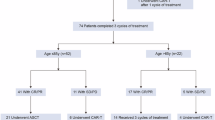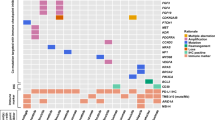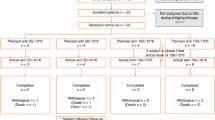Abstract
Between September 1986 and June 1998, 99 patients with relapsed or refractory IGL received intensified preparative therapy and underwent autologous transplantation at a single institution. Two intensified preparative regimens were used: cyclophosphamide, etoposide, total body irradiation (CY-VP-TBI) (n = 66) and cyclophosphamide, BCNU, etoposide (CBV) (n = 33). As clinical features and results were not different for the two preparative regimens, results were combined. For all patients undergoing autologous transplantation, 5-year actuarial overall survival (OS) was 34% ± 6%; 5-year event-free survival (EFS) was 26% ± 5%. For patients who responded to primary therapy, salvage therapy, or both, OS was 42% ± 7%; for non-responders to prior therapy, OS was 14% ± 7%, P < 0.025. OS was better among patients responding to salvage therapy (50% ± 9%), than among patients who had a complete response to initial therapy, but failed to respond or were untested/unevaluable with respect to salvage therapy (26% ± 10%; P < 0.025). On multivariate analysis, response to salvage therapy was associated with survival following autologous transplantation (P < 0.005). Treatment related mortality was 9% overall and only 6% after G-CSF and GM-CSF were introduced into routine clinical practice. High-intensity preparative therapy is highly effective, with acceptable treatment-related mortality, in patients with IGL who have responded to induction therapy, salvage therapy, or both. The best responses are observed in patients responding to salvage therapy. Randomized prospective studies will be needed to further define the role of intensified preparative regimens. Bone Marrow Transplantation (2000) 25, 257–262.
This is a preview of subscription content, access via your institution
Access options
Subscribe to this journal
Receive 12 print issues and online access
$259.00 per year
only $21.58 per issue
Buy this article
- Purchase on SpringerLink
- Instant access to full article PDF
Prices may be subject to local taxes which are calculated during checkout



Similar content being viewed by others
References
Phillips GL, Herzig RH, Lazarus HM et al. Treatment of resistant malignant lymphoma with cyclophosphamide, total body irradiation, and transplantation of cryopreserved autologous bone marrow New Engl J Med 1984 310: 1557–1561
Philip T, Armitage JO, Spitzer G et al. High dose therapy and autologous marrow transplantation after failure of conventional chemotherapy in adults with intermediate grade or high grade non-Hodgkin's lymphoma New Engl J Med 1987 316: 1493–1498
Takvorian TM, Canellos GP, Ritz J et al. Prolonged disease-free survival after autologous bone marrow transplantation after failure of conventional chemotherapy in adults with intermediate grade or high grade non-Hodgkin's lymphoma with a poor prognosis New Engl J Med 1987 316: 1499–1505
Armitage JO . Bone marrow transplantation in the treatment of patients with lymphoma Blood 1989 73: 1749–1758
Freedman AS, Nadler LM . Which patients with relapsed non-Hodgkin's lymphoma benefit from high dose therapy and hematopoietic stem cell transplantation? (Editorial) J Clin Oncol 1993 11: 1841–1843
Gribben JG, Goldstone AH, Linch DC et al. Effectiveness of high-dose combination chemotherapy and autologous bone marrow transplantation for patients with non-Hodgkin's lymphoma who are still responsive to conventional dose therapy J Clin Oncol 1989 7: 1621–1629
Vose JM, Armitage JO, Bierman PJ et al. Salvage therapy for relapsed or refractory non-Hodgkin's lymphoma utilizing autologous bone marrow transplantation Am J Med 1989 87: 285–288
Phillips G, Fay J, Herzig R et al. The treatment of progressive non-Hodgkin's lymphoma with intensive chemoradiotherapy and autologous marrow transplantation Blood 1990 75: 831–838
Stiff PJ, Dahlberg S, Forman SJ . Autologous bone marrow transplantation for patients with relapsed or refractory diffuse aggressive non-Hodgkin's lymphoma: value of augmented preparative regimens – A Southwest Oncology Group Study J Clin Oncol 1998 16: 48–55
Gulati S, Yahalom J, Acaba L et al. Treatment of patients with relapsed and resistant non-Hodgkin's lymphoma using total body irradiation, etoposide, cyclophosphamide and autologous bone marrow transplantation J Clin Oncol 1992 10: 936–941
Horning SJ, Negrin RS, Chao NJ et al. Fractionated total-body irradiation, etoposide, and cyclophosphamide plus autografting in Hodgkin's disease and non-Hodgkin's lymphoma J Clin Oncol 1994 12: 2552–2558
Weaver CH, Peterson FB, Applebaum FR et al. High dose fractionated total-body irradiation, etoposide, and cyclophosphamide followed by autologous stem cell support in patients with malignant lymphoma J Clin Oncol 1994 12: 2559–2566
Miller G, Brashear T, Stone M, Fay J . Elimination of clonigenic tumor cells from bone marrow using methylprednisolone and etoposide. An in vivo pharmacologic study Int J Cloning 1991 9: 503–510
Velasquez WS, Cabanillas, Salvador P et al. Effective salvage therapy for lymphoma with cisplatin in combination with high-dose ARA-C and dexamethasone (DHAP) Blood 1988 71: 117–122
Kaplan EL, Meier P . Non-parametric estimation from incomplete observations J Am Stat Assoc 1958 53: 457–481
Waits TM, Greco FA, Greer JP et al. Effective therapy for poor prognosis non-Hodgkin's lymphoma with 8 weeks of high-dose-intensity combination chemotherapy J Clin Oncol 1993 11: 943–949
Philip T, Guglielmi C, Hagenbeek A et al. Autologous bone marrow transplantation as compared with salvage chemotherapy in relapses of chemotherapy sensitive non-Hodgkin's lymphoma New Engl J Med 1995 333: 1540–1545
Author information
Authors and Affiliations
Rights and permissions
About this article
Cite this article
Stein, R., Greer, J., Goodman, S. et al. Intensified preparative regimens and autologous transplantation in refractory or relapsed intermediate grade non-Hodgkin's lymphoma. Bone Marrow Transplant 25, 257–262 (2000). https://doi.org/10.1038/sj.bmt.1702132
Received:
Accepted:
Published:
Issue date:
DOI: https://doi.org/10.1038/sj.bmt.1702132
Keywords
This article is cited by
-
Autotransplant conditioning regimens for aggressive lymphoma: are we on the right road?
Bone Marrow Transplantation (2007)
-
Diagnostic strategy in cancer patients with acute respiratory failure
Intensive Care Medicine (2006)



